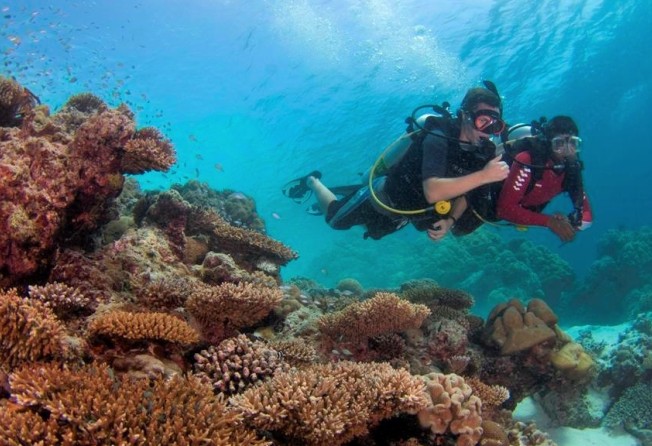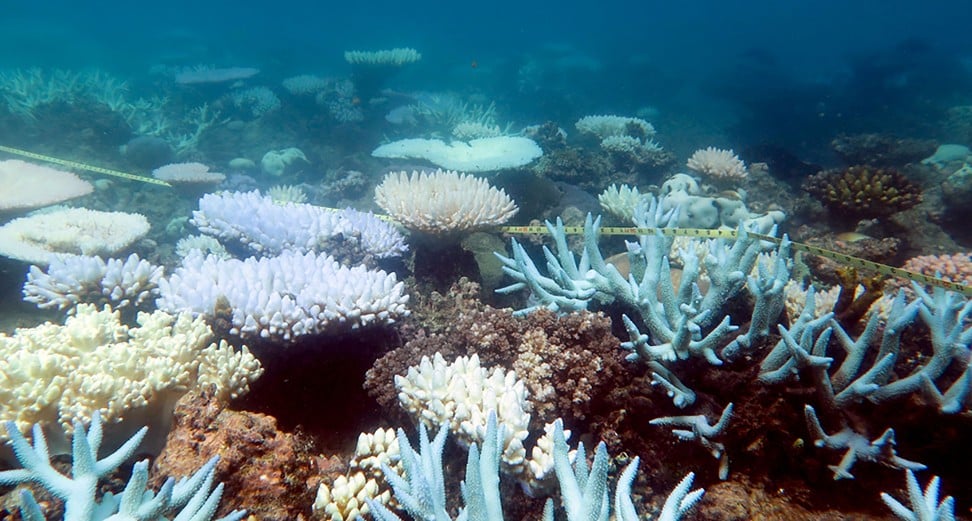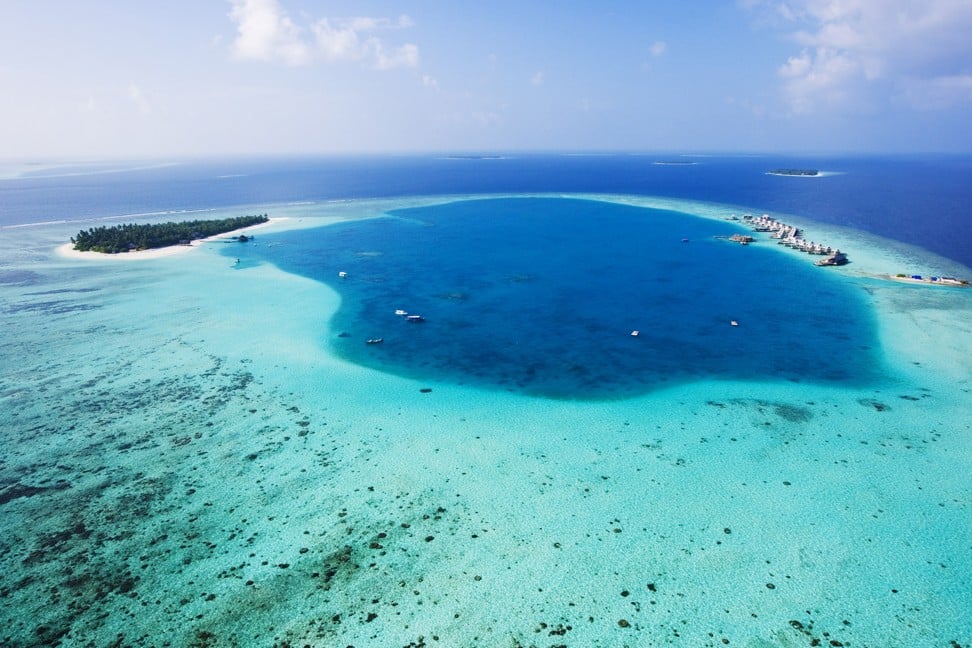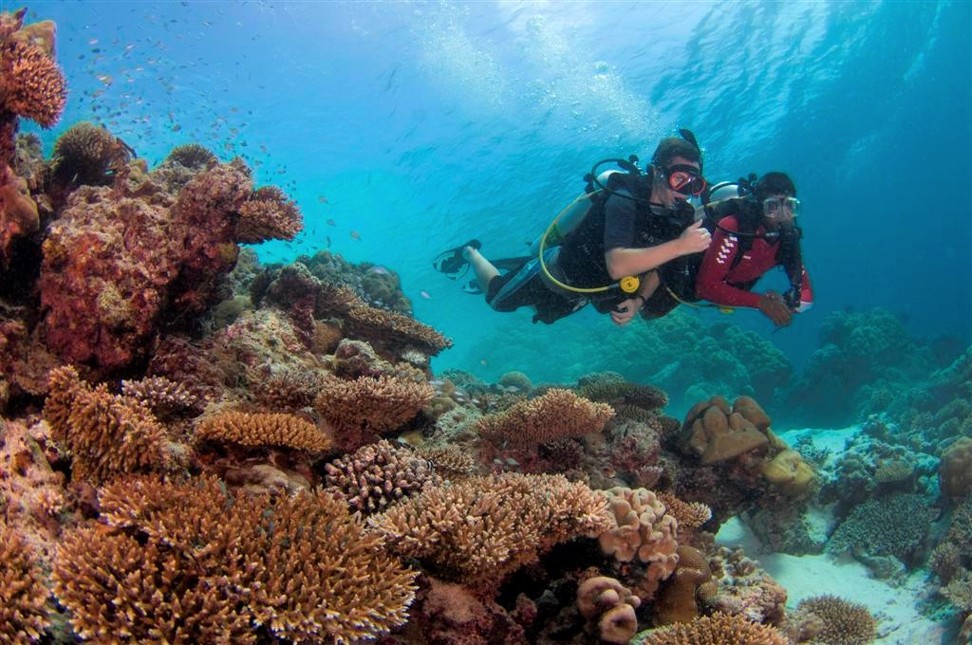A post shared by Gonzalo Giribet (@invertebrados) on Sep 13, 2015 at 6:44am PDT
What is Banyan Tree doing to save coral reefs in the Maldives?
The resort group, which has set up two marine conservation labs in the Maldives, is committed to restoring the coral reefs affected by bleaching

Coral reefs used to evoke colourful images of golden orange, bright blue and lime green, but sadly that’s not the case any more.
Coral bleaching over the last 20 years has left the once vivid underwater rainforests a lifeless shade of white. The culprit behind this? Warmer water temperatures.
Unusually warm water and fickle conditions have made corals expel the algae living in their tissues. The corals turn pale and become more susceptible to disease and, therefore, death.
Mass bleaching plagued coral reefs around the world in 1998, 2002, 2006 – with the most recent episode happening in 2016, which brought on a record widespread of coral bleaching in the Great Barrier Reef, according to the Australian Institute of Marine Science.
The Maldives, famous for its vibrant coral life, has suffered a loss of around 60 to 90 per cent of its corals since 2014, according to CNN.
Banyan Tree Hotels and Resorts, which has been concentrating its efforts on global conservation since 1996, spearheads the coral recovery programmes in the Maldives. The hospitality group built the first marine lab at its hotel in Vabbinfaru in 2004 and stationed its second at Angsana Velavaru – “Turtle Island” in Dhivehi – in 2007.
The first resort group to hire marine biologists for the protection and education of coral reefs, Banyan Tree focuses on six projects – coral reef restoration, reef monitoring, reef conservation, shark conservation, education and a citizen science programme.
The Banyan Tree Global Foundation was established in 2009 as the corporate social responsibility arm of the hotel group. Six years later, Dr Steven Newman – who has a PhD in marine ecology – became the foundation’s sustainability director and coordinating director. Dr Newman oversees sustainability initiatives across all Banyan Tree resorts.
We talked to Dr Newman about coral reef restoration, and what’s it like working in one of the most beautiful places on Earth. Here’s what he said:
1. Why was the Maldives chosen to be the location of the marine conservation lab?
Over the past few decades, the Maldives has risen to the forefront of the tourism sector, drawing in millions of tourists every year. Issues that remain invisible to the masses, from island erosion to waste management, became a threat. On top of that, rising temperatures of the seawater have led to severe coral bleaching. Banyan Tree was founded with the core value of driving sustainable development and, in this case, we saw the opportunity to [establish] our own marine conservation facility to help tackle the problems that the Maldives is facing.
2. How did coral bleaching in 2016 affect the community and ecosystem in the Maldives?
Global coral bleaching in 2016 devastated many reefs worldwide, and the Maldives experienced widespread and, in some places, severe bleaching. Warm ocean temperatures led to the death of corals, particularly those in shallow waters. In some parts of the Maldives, we lost about 90 per cent of our corals.
After coral bleaching, we measured changes in coral cover and the fish communities they support. Corals reefs are a big draw for tourism in the Maldives, and tourism did take a hit. However, Velavaru house reef, and many of the other reefs in this atoll, fared particularly well during the bleaching, and still retain high coral cover.
The reefs that were affected are showing show strong signs of resilience and recovery thanks to healthy and diverse reef fish communities. Conservation efforts further support the recovery of the reefs.
3. Tell us more about the restoration procedures of the coral reefs. How is the situation looking?
Protecting and restoring large areas of coral reefs requires the management of human behaviour and other forms of stress such as sediments and mortality (from crown-of-thorns starfish). We are taking an active approach in nurturing and transplanting corals on to the reefs to to help them recover.
Our coral reef restoration efforts are supported by four coral nurseries, one each on Vabbinfaru and Ihuru, and two on Velavaru. Up to 1,000 coral fragments are grown in each nursery. The fragments are attached to ropes at a sufficient depth to avoid the warm surface waters. Once reaching a suitable size, these corals will be transplanted directly to our house reef.
Our marine lab team, staff and guests all support reef restoration efforts at Angsana Velavaru. The primary focus of our conservation efforts is Velavaru, and we have been [doing great]. In the last two months, we have transplanted 3,000 corals onto the Velavaru reef.
4. The Maldives, where Banyan Tree has three hotels, has always been a hot tourist spot because of its natural beauty. Are the hotels helping the ecosystem and sustainable development?
Having multiple locations in the Maldives allows us to access and increase the range and degree of support and benefit we can contribute to both the environment and local communities. Using a stakeholder inclusive approach, we connect with communities, support livelihoods, broaden education and raise awareness. We have developed the capacity to adapt to change and protect the environment which so many people depend on. Having a greater presence means we can combine forces to support initiatives, increase awareness of good practices, and help others build sustainable development and livelihoods.
5. What do you see as the greatest challenge to the conservation work you're doing in the Maldives?
Our conservation efforts face many challenges, and balancing the needs of the environment and the needs of the people requires a sensitive and delicate approach. Potentially the hardest challenge to overcome is people’s behaviour [they have to be patient to witness the positive results of our projects]. Climate change is also a big challenge.
A small change can ultimately have a large impact. Bringing people together, educating them about the problems, and teaching them how to adapt and overcome them, is the greatest challenge, but it’s also the most rewarding one.
6. Are there any short-term goals in the lab’s objectives of conservation, restoration, education and research?
We have a conservation strategy, which addresses global and local threats to key ecosystems and priority species. In the Maldives, our focal ecosystem is coral reefs, and our current priority species is sharks. Our goal is to better understand the impact, resilience and recovery of coral reefs from the last bleaching event. We are also studying the impact of the national ban on shark fishing on shark populations and the livelihoods of local communities. We use research to help us better understand everything and to educate people.
7. Walk me through your daily work at the lab.
Daily work in the marine lab is diverse. We engage with guests to introduce them to the incredible natural environment in the Maldives. We give them opportunities to learn through educational talks, and, more actively, through citizen science (snorkelling and recording animals they see). We also teach them how to plant corals.
We work with local and national non-governmental agencies, universities, researchers, government ministries, and local communities on conservation. This means most days are a combination of time in the water, time engaging with people and sharing our knowledge, and time collecting and analysing data that can be used to guide our efforts.
8. How can visitors take part in the lab's initiatives?
Awareness and education are the cornerstones to environmental conservation. The lab teaches guests about marine conversation. Over the years, the lab has conducted research on the conservation and ecology of corals and coral reefs, sea turtles, sharks and fishes. Through presentations, lectures, ecotours and snorkelling, visitors can learn about the local environment and help us with our efforts including reef conservation. We integrate education in all our activities to familiarise visitors with the natural heritage of the Maldives.
9. What are some Banyan Tree sustainability initiatives that have made an impact on you personally?
My role is to identify, design and implement sustainability initiatives. One [initiative] that stood out was after the tsunami hit the Maldives. Banyan Tree Hotels and Resorts worked with the UNDP [United Nations Development Programme] and Red Cross to reconstruct an entire island, Naalaafushi, in the Maldives. Such a selfless effort, to ensure the welfare and sustainability of local communities, is rarely seen. This is the mindset of all our environmental and social programmes, whether big or small.
10. Where is your go-to diving spot?
Around Velavaru, there are many reefs that have retained high coral cover and have not been affected by the bleaching in 2016. There are a lot of great diving spots, but you can also see many things while snorkelling.






